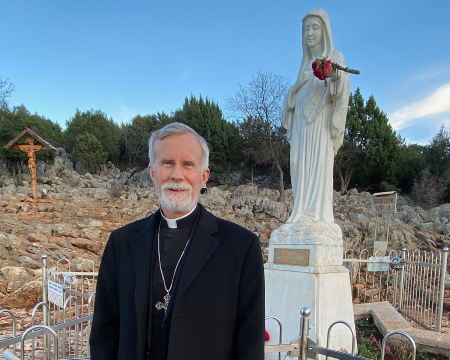John Talaia
FREE Catholic Classes
Orthodox Patriarch of Alexandria (481-482) at the time of the Monophysite troubles. He had been a monk in the Canopis and administrator ( megas oikonomos ) of the diocese under the Patriarch Timothy Salofaciolus, who had sent him with Gennadius of Hermopolis as legate to the Emperor Zeno (474-491). Zeno was on very good terms with John Talaia, in whom every one foresaw the future Patriarch of Alexandria ( Evagrius, "H.E.," III, xii; Felix III, Ep. i, 10, ii, 4, in Thiel, "Epist. Rom. Pont.," Braunsberg, 1867). It was said by his enemies that he was vain and ambitious, that he spent large sums of money in bribing courtiers and behaved as if he were already patriarch. He quarrelled with Acacius of Constantinople (471-489) however, who became his implacable enemy. Acacius afterwards said that Talaia had sworn that he would not accept the patriarchate. Just before his death, Timothy Salofaciolus again sent John Talaia to Constantinople with the petition that when he, Timothy, died he might have a Catholic (Chalcedonian) successor. This time, too, Talaia enjoyed the Emperor's favour. Zeno promised all he asked and spoke with great admiration of Timothy's pious legate. But Talaia ignored Acacius, who shut himself up and awaited his chance of revenge. Talaia made friends among the courtiers, ingratiating himself especially with a certain Illus, administrator of the palace. As soon as Timothy died (481) the Catholics of Alexandria chose John Talaia to succeed him. Unfortunately the new patriarch then offended the emperor and gave Acacius his chance. He announced his succession at once to Rome and Antioch, according to custom. But he sent no announcement to the Patriarch of Constantinople, only writing to Illus begging him to tell the emperor. Illus was away at Antioch ; so people at Constantinople heard the news before the official announcement arrived. This Zeno took as a personal affront. Acacius stepped in to take advantage of the situation. He persuaded Zeno that Talaia had broken his oath in accepting election and had advised his clergy to restore the name of the great Monophysite champion, Dioscorus, to their diptychs. This accusation was sheer calumny. Talaia was always unimpeachably orthodox. Zeno then refused to acknowledge Talaia and supported his rival Peter Mongus.
We ask you, humbly: don't scroll away.
Hi readers, it seems you use Catholic Online a lot; that's great! It's a little awkward to ask, but we need your help. If you have already donated, we sincerely thank you. We're not salespeople, but we depend on donations averaging $14.76 and fewer than 1% of readers give. If you donate just $5.00, the price of your coffee, Catholic Online School could keep thriving. Thank you.Help Now >
Peter Mongus ( Moggos , hoarse) was a Monophysite who had already been set up as patriarch by his party when Timothy Ailuros died (477). During the life of Salofaciolus he had not made much headway; but now he was again brought forward by the Monophysites as rival patriarch to Talaia. Acacius had formerly been an enemy of Mongus ; now he and the emperor supported him. The situation was further complicated by the publication of the famous "Henoticon" (482), by which Zeno and Acacius hoped to conciliate the Monophysites (see HENOTICON ). Peter Mongus accepted it at once, whereas Talaia rejected it. Zeno then wrote to the pope (Simplicius, 463-483), saying that Talaia was unworthy of the See of Alexandria , being a perjurer and friend of Dioscorus, that Mongus was the right man to be patriarch. A result of this letter was that the Holy See did not at once acknowledge Talaia. But the pope answered the emperor, refusing to admit Mongus as patriarch in any case. Zeno, however, ordered the governor ( dux ) of Egypt to expel Talaia and establish Mongus in his place. Mongus then sent notice of his succession to Rome, Antioch, and Constantinople. Acacius acknowledged him and inserted his name in the Byzantine diptychs. Talaia, expelled from Alexandria, fled to Rome in 483. He there explained the whole situation to the pope and persuaded him to write two letters to Acacius denouncing Mongus. So also he was the adviser of the next pope, Felix II (or III, 483-492), in the great controversy about Mongus and the "Henoticon" that led to the Acacian schism. Mongus from this time became the great subject of dispute. Communion with him meant Monophysitism. John Talaia practically disappeared from the field. He stayed at Rome under the pope's protection (always of course opposed to Mongus and the "Henoticon" ) helping the papal court with his advice and knowledge of Eastern affairs. Liberatus thinks he became Bishop of Nolana in the Campagna, Le Quien thinks this unlikely (Oriens Christ., IL 419). Under Gelasius 1 (492-496) Talaia's name still occurs as that of a counsellor whose advice the pope willingly followed. He was never able to go back to his own see and died at Rome at a date unknown.
It may be of interest to note that Paul Drews ("Zur Entstehungsgeschichte des Kanons in der rõm. Messe," Tübingen, 1902) attributes the present arrangement of the Canon of the Mass in some measure to John Talaia of Alexandria. His thesis is this: Originally the order of the Canon corresponded to the Antiochene Anaphora. It was re-arranged in the fifth century to make it conform more or less to the Alexandrine Liturgy, most probably by Gelasius I by the advice of his influential guest (op. cit., p. 38).
 Hi readers, it seems you use Catholic Online a lot; that's great! It's a little awkward to ask, but we need your help. If you have already donated, we sincerely thank you. We're not salespeople, but we depend on donations averaging $14.76 and fewer than 1% of readers give. If you donate just $5.00, the price of your coffee, Catholic Online School could keep thriving. Thank you. Help Now >
Hi readers, it seems you use Catholic Online a lot; that's great! It's a little awkward to ask, but we need your help. If you have already donated, we sincerely thank you. We're not salespeople, but we depend on donations averaging $14.76 and fewer than 1% of readers give. If you donate just $5.00, the price of your coffee, Catholic Online School could keep thriving. Thank you. Help Now >








 Daily Readings for Saturday, April 20, 2024
Daily Readings for Saturday, April 20, 2024 St. Marian: Saint of the Day for Saturday, April 20, 2024
St. Marian: Saint of the Day for Saturday, April 20, 2024 Children's Prayer For Parents: Prayer of the Day for Saturday, April 20, 2024
Children's Prayer For Parents: Prayer of the Day for Saturday, April 20, 2024
